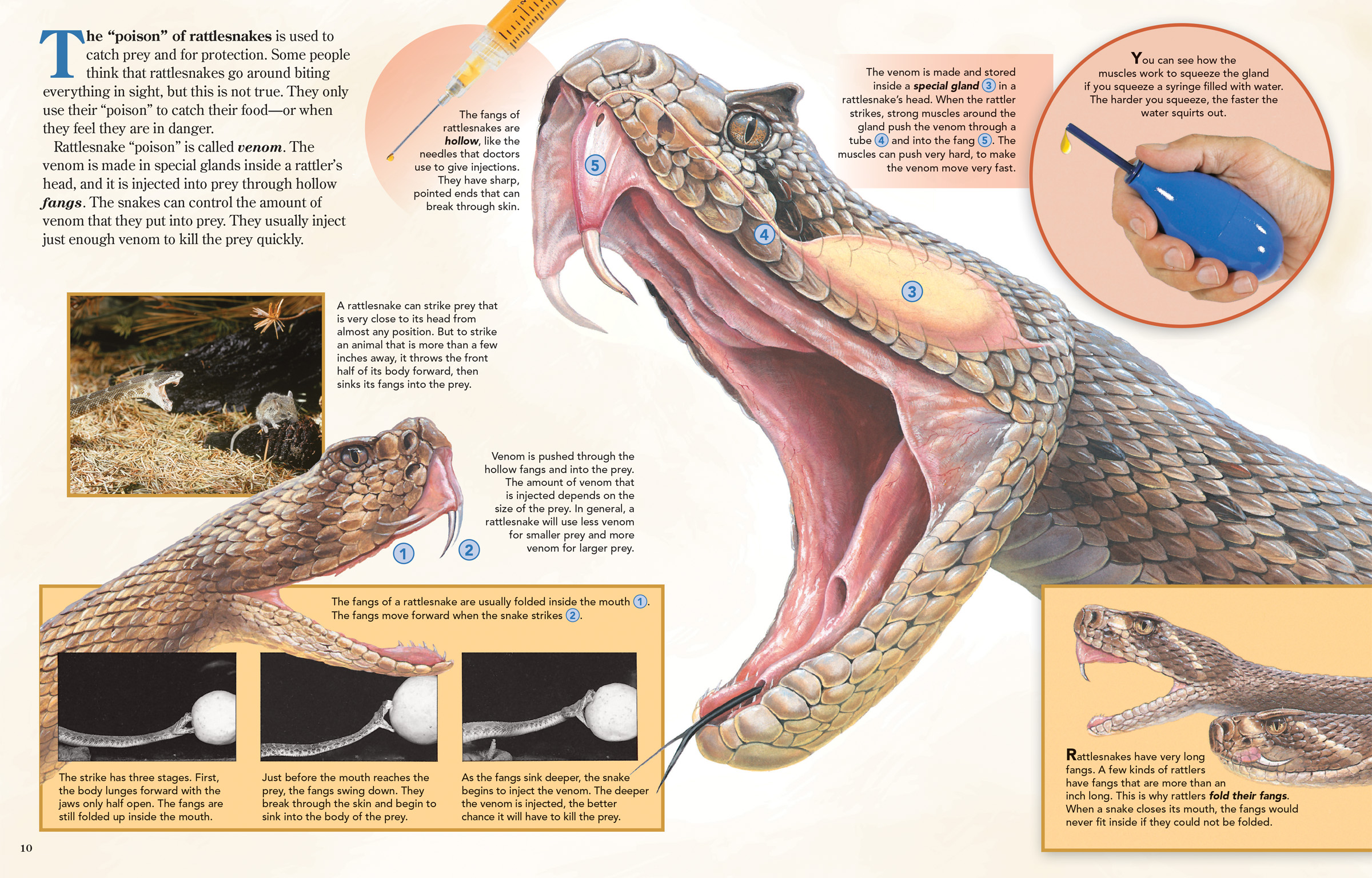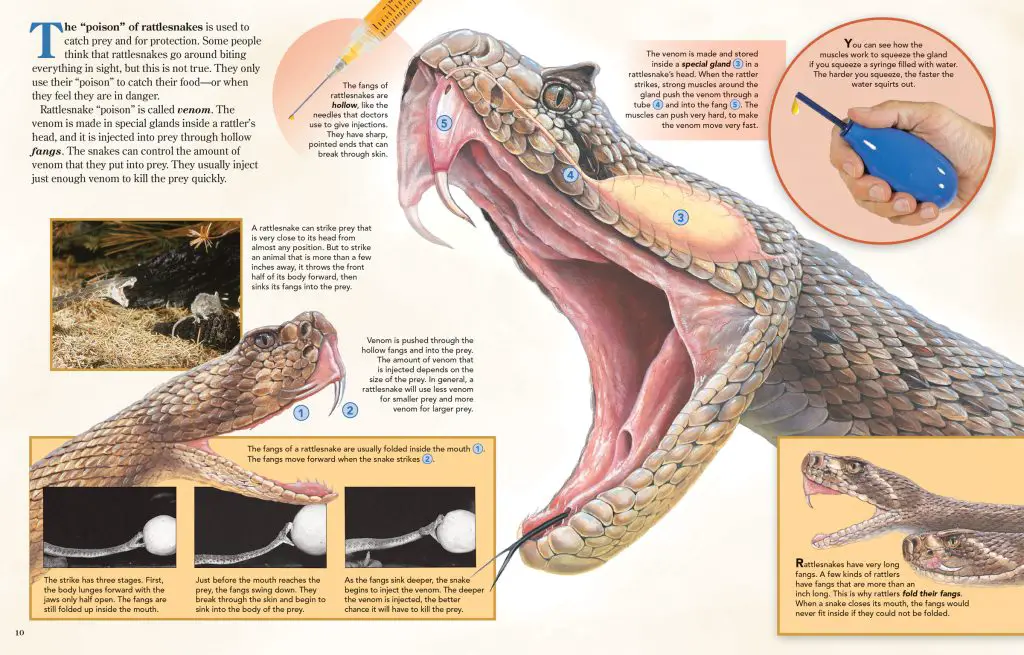Rattlesnakes are known for their venomous bites that can cause serious harm to humans and animals alike. While some people can survive a rattlesnake bite with proper medical attention, others may not be so lucky. This raises the question: how fast does rattlesnake venom work?
The speed at which rattlesnake venom works can vary depending on several factors, including the victim’s size and health, the location of the bite, and the type of rattlesnake. Understanding how quickly the venom can affect the body can help people take the necessary precautions and seek medical attention if necessary. Let’s dive deeper into this intriguing topic and explore the fascinating world of rattlesnake venom.
Rattlesnake venom can work quickly, depending on the amount injected and the location of the bite. In general, the venom can start working within minutes to hours, causing symptoms such as pain, swelling, and difficulty breathing. However, the full effects of the venom may take several hours to develop, and can lead to serious complications if left untreated.

How Fast Does Rattlesnake Venom Work?
Rattlesnakes are venomous snakes that are common in North and South America. They are known for their distinctive rattling sound that warns potential predators and prey of their presence. Rattlesnakes inject venom into their prey or attackers using their fangs. The venom is a complex mixture of proteins and enzymes that can cause a variety of symptoms in humans. In this article, we will explore how fast rattlesnake venom works and its effects on the human body.
What is Rattlesnake Venom?
Rattlesnake venom is a complex mixture of enzymes and proteins that are toxic to humans and animals. The venom is produced in the venom glands located behind the eyes of the snake. When the snake bites its prey or attacker, the venom is injected into the victim’s bloodstream through its fangs.
The composition of rattlesnake venom varies among different species of rattlesnakes. Some venom can cause damage to the nervous system, while others can cause tissue damage or bleeding disorders. The type of symptoms that occur after a rattlesnake bite depends on the specific venom composition.
How Fast Does Rattlesnake Venom Work?
The speed at which rattlesnake venom works depends on several factors, including the amount of venom injected, the location of the bite, and the victim’s age and health. In general, the venom can start to take effect within minutes to hours after a bite.
The first symptoms of a rattlesnake bite are often pain and swelling at the site of the bite. The venom can also cause nausea, vomiting, and dizziness. As the venom spreads throughout the body, it can cause muscle weakness, difficulty breathing, and even paralysis. In severe cases, the venom can lead to organ failure and death.
Types of Rattlesnake Venom
There are several types of rattlesnake venom, each with different effects on the body. Neurotoxic venom affects the nervous system and can cause paralysis and respiratory failure. Hemotoxic venom affects the blood vessels and can cause tissue damage, bleeding, and organ failure. Cytotoxic venom affects the cells and can cause tissue damage and necrosis.
The type of venom that a rattlesnake uses depends on its species and geographic location. It’s important to identify the type of rattlesnake that caused the bite to determine the appropriate treatment.
How Is Rattlesnake Venom Treated?
The treatment for a rattlesnake bite depends on the severity of the symptoms and the type of venom. In general, the first step is to immobilize the affected limb and keep the victim calm. The victim should be transported to a hospital as soon as possible.
Antivenom is the primary treatment for rattlesnake bites. Antivenom is a serum that contains antibodies that neutralize the venom. The antivenom is administered intravenously and can help reduce the severity of symptoms and prevent complications.
Other treatments may include pain management, wound care, and supportive care for organ failure. It’s important to seek medical attention immediately after a rattlesnake bite to reduce the risk of complications.
Preventing Rattlesnake Bites
Preventing rattlesnake bites is the best way to avoid the effects of rattlesnake venom. Some tips for preventing rattlesnake bites include:
– Be aware of your surroundings when hiking or camping in areas where rattlesnakes are common
– Wear protective clothing, such as long pants and boots, when hiking in rattlesnake habitats
– Avoid reaching into areas where you can’t see, such as rock crevices or holes in the ground
– Keep your pets on a leash when hiking in rattlesnake habitats
– Do not handle or approach rattlesnakes, even if they appear to be dead
By taking these precautions, you can reduce your risk of a rattlesnake bite and the effects of rattlesnake venom.
Rattlesnake Venom: Benefits Vs. Risks
While rattlesnake venom can be deadly to humans, it has some potential benefits. Researchers are studying rattlesnake venom for its potential in treating cancer, autoimmune diseases, and pain. The venom contains proteins and enzymes that may have therapeutic properties.
However, the risks of rattlesnake venom outweigh the potential benefits for most people. The venom can cause severe symptoms and even death in some cases. It’s important to avoid contact with rattlesnakes and seek medical attention immediately if you are bitten.
Conclusion
Rattlesnake venom is a complex mixture of toxic proteins and enzymes that can cause a variety of symptoms in humans. The speed at which the venom works depends on several factors, including the amount of venom injected, the location of the bite, and the victim’s age and health.
Treatment for rattlesnake bites includes antivenom, wound care, and supportive care for organ failure. Prevention is the best way to avoid the effects of rattlesnake venom. By taking precautions and avoiding contact with rattlesnakes, you can reduce your risk of a rattlesnake bite and the effects of rattlesnake venom.
Frequently Asked Questions
What happens when a rattlesnake bites you?
When a rattlesnake bites you, it injects venom into your body through its fangs. The venom contains a mixture of proteins and enzymes that can damage your tissues, affect your blood flow, and cause a range of symptoms, such as pain, swelling, bleeding, and organ failure. The severity of the symptoms depends on the amount and type of venom, as well as your age, health, and immune system.
How long does it take for rattlesnake venom to take effect?
The time it takes for rattlesnake venom to take effect can vary depending on several factors. In general, the symptoms start to appear within a few minutes to a few hours after the bite. However, some people may experience a delayed reaction, which can occur up to 24 hours later. The speed of the venom’s effect also depends on the type of rattlesnake and the amount of venom injected.
What are the symptoms of rattlesnake envenomation?
The symptoms of rattlesnake envenomation can vary depending on the type of rattlesnake and the amount of venom injected. However, some common symptoms include pain, swelling, redness, bleeding, nausea, vomiting, dizziness, weakness, and difficulty breathing. In severe cases, the venom can cause organ failure, shock, and death. It is important to seek medical attention immediately if you are bitten by a rattlesnake.
How is rattlesnake envenomation treated?
The treatment for rattlesnake envenomation usually involves the use of antivenom, which is a medication that can neutralize the venom and prevent further damage. Other treatments may include pain medication, wound care, and supportive care, such as fluids and oxygen therapy. The specific treatment depends on the severity of the envenomation and the individual’s health status.
How can I prevent getting bitten by a rattlesnake?
To prevent getting bitten by a rattlesnake, it is important to be aware of your surroundings and avoid areas where rattlesnakes may be present, such as rocky areas, tall grass, and woodpiles. Wear protective clothing, such as boots and long pants, when hiking or working outdoors. If you encounter a rattlesnake, give it plenty of space and do not try to handle or approach it. If you do get bitten, seek medical attention immediately.
How Does Snake Venom Work? | World’s Worst Venom | Spark
In conclusion, the speed at which rattlesnake venom works can vary depending on several factors. The type and amount of venom injected, as well as the size and health of the victim, can all play a role in how quickly the venom takes effect.
However, despite these variables, it is generally accepted that rattlesnake venom can work very quickly. Some victims may experience symptoms within minutes of being bitten, while others may take several hours to show any signs of venom toxicity.
Overall, it is important to seek immediate medical attention if you are bitten by a rattlesnake or suspect that you have been exposed to its venom. With proper treatment, the effects of rattlesnake venom can be managed and even reversed, allowing victims to recover and move forward with their lives.


